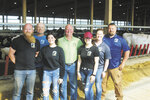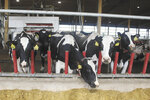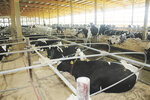


MARATHON, Wis. — A robotic milking system has been on the radar at Draeger Dairy near Marathon for nearly a decade.
After years of contemplation, 12 Lely Astronaut A5 robotic milking units were fired up Aug. 21, 2023, launching the Draeger family into a new era on their Marathon County farm.
Draeger Dairy, home to nearly 700 milking cows, is operated by brothers Jim Draeger and Alan Draeger, along with Jim’s children, Heidi and Aaron Gauerke, TJ Draeger, Teanna Draeger and Kylie Draeger.
Nearly 550 cows call the robotic barn home. The other 150 cows continue to live in the older freestall barn and are milked in a double-12 parlor. Eventually, the Draegers hope to fill both barns and milk the facility’s capacity of 900 cows.
Since moving into the facility, the herd is averaging 92 pounds of milk per cow per day, with an energy-corrected equivalent of nearly 100 pounds.
The Draegers are inviting others interested in the technology to view theirs in an open house from 10 a.m. to 2 p.m. June 15.
“For the past 10 years, I have been saying that robots were going to be our future,” Heidi said.
While Heidi was the early advocate and long convinced of the value robots could play in the farm’s future, the rest of her family came on board about four years ago. Like many farms, labor issues were the driver that ultimately brought robotic milking to the farm.
“We have a lot of local competition for labor,” Aaron said.
Jim agreed. He said the financial implications of procuring staff convinced him.
“It’s a struggle to find employees to milk the cows, especially knowing that employee wages and benefits like health insurance and workers compensation continue to escalate,” Jim said. “You know that robot is not going to ask for a raise. It is not going to call in sick.”
When the decision was made, the Draegers investigated the technology available and researched and toured facilities.
“The reputation of Seehafers and Lely were huge, knowing you have dealer support and knowledge,” TJ said. “Lely focuses on robots. They are on the forefront of robots, driving the innovation.”
As a team, the Draegers felt the free-flow model was the best fit for their cows.
“We visited both free-flow and guided-flow barns, and by the end, we were all on the same page that the free-flow offered superior cow comfort,” Jim said.
The decision was not made lightly.
“It honestly took me a little while to get on board with the idea of free-flow traffic,” TJ said. “We built the parlor in 1996. You have it in your head, ‘I have to tell these cows what to do.’ But once we started going on tours, I realized the benefits of just letting cows do what cows do.”
They selected Sensenig Construction as the contractor to build the barn.
“We bid it out and toured the manufacturing facility and looked at the other barns they have built, and we liked what we saw,” Aaron said. “Our barn is unique in that it is all wood. You don’t see a lot of all-wood barn constructions. The aesthetic is very pleasing.”
The tunnel-ventilated barn is configured into four pens, each containing three robots placed in an L-shaped formation. Each pen has a sort pen attached, allowing cows to be separated for health work, breeding and hoof trimming.
With the design of their barn, the Draegers placed the feed mangers on the outside perimeter of the pens. Each pen is equipped with stainless steel, tip-over water troughs, which are cleaned daily.
With cow comfort being a priority, the Draegers opted to install the Agromatic FreeFEED natural feed system over a traditional neck rail.
“There is no restriction to the cows lifting their head,” Jim said. “They can eat in a more natural position, and they aren’t rubbing calluses on their necks. You can walk in and out of the pens anyplace, without having to crawl through. It’s like having 600 man-passes.”
The only headlocks in the barn are in the sort pens.
“I spent a lot of time looking for the quietest headlocks I could find,” said Heidi, of her choice of Cosnet headlocks. “A robot barn is supposed to be quiet, not full of clanging headlocks.”
Fiberglass stall dividers were chosen for the free stalls, based on their low cost and easy maintenance.
Each pen is equipped with a footbath, located at the outside end. The footbaths are filled each Monday and cows are pushed through them. The gates are left open through Tuesday night. Then, they are closed, and the footbaths are drained and flushed for use the next week.
“The cows love the footbaths,” Teanna said. “If the gates are open, they want to be in there.”
The design of the new barn allows the Draegers to operate three feed systems. They are using two to feed two different pellets in the robots, based on the ration the cows receive.
Two Lely feed pushers operate eight times daily. The aisles are scraped using Valmetal alley scraper drivers on custom-built sleds.
Because of natural slope, the barn is built on a single plane with a 2% slope throughout the building. Two cross channels are used to carry manure from the barn. As an experiment, half the barn is sand bedded once a week while the other half has waterbeds covered with sawdust and hydrated lime. Each half of the barn is emptied using a different system.
“Sand is expensive to haul in and out, and it wears stuff out in between,” TJ said. “The problem is the cows like days at the beach just as much as I do.”
Compared to the labor force required to milk the entire herd in the parlor, the robotic barn requires minimal staff.
“We have two people working in there during the day and one person overnight,” Heidi said.
Keeping things simple and focused on the cows has allowed the Draegers to reach their goal of increased labor efficiency.
“We really put a lot of thought into figuring out how we can do the most for the cows with the least amount of people,” Aaron said.
Comments
No comments on this item Please log in to comment by clicking here